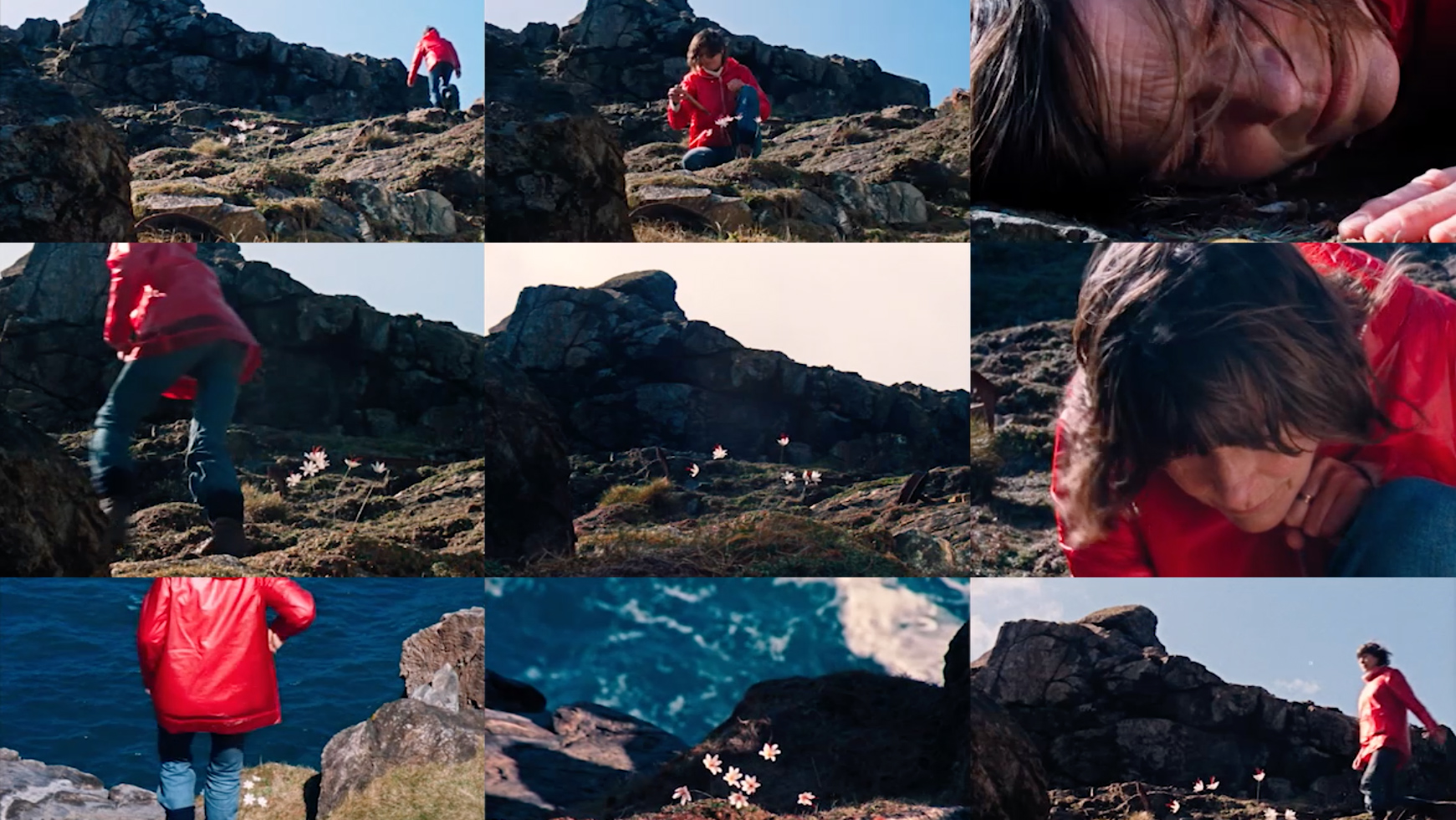Film’s bias toward linearity is evidenced in its physical construction, from strips of film spliced one after the other that create a single material continuum, to sequentially placed clips on a digital editing timeline. However, filmmakers’ attempts to distort and undermine this linearity is as old as the form itself, from The Great Train Robbery (Edwin S. Porter, 1903) – which broke the rules of continuity even as it was establishing them (Gaudreault 43) – to experimental films like Hollis Frampton’s Nostalgia (1971), or Christopher Nolan’s mainstream features (Following [1998], Memento [2000], Tenet [2020]). This video essay examines Mark Jenkin’s sophisticated subversion of linearity in Enys Men (2022), with a broader focus on how film music may participate in the disruption of linearity and time in film art.
Enys Men (“stone island” in Cornish) is the story of a solitary woman completing repetitive daily tasks. The Volunteer (Mary Woodvine) leaves her cottage, hikes to a remote location, observes a rare flower, drops a rock in an abandoned mine shaft, comes home, and makes tea.
Again, and again, and again.
As narrative, visual – and notably – sonic repetition build in Enys Men, it becomes unclear whether The Volunteer is moving into the future, the past, or is stuck in an eternal loop of the present. She interacts with the island’s past inhabitants, as well as future events, occasionally even coming face to face with multiple instances of herself.
I frame my video with a quote by music theorist Rebecca Leydon: “…I am wondering what kinds of subjectivities are possible when musical syntax is undermined by obstinate motivic repetition” (2002). Leydon asks this in the context of an analysis of Minimalist music of the 1960s and 70s – music famous for its dizzying use of repetition – but her question and argument apply to film music broadly, and Enys Men specifically. Two music theory concepts warrant brief examination. “Musical syntax” refers to the broad set of compositional practices, specific to different types of music, which are used to create structure and meaning. Musical syntax, like the syntax of sentence structure or noun/verb relationships in language, may be intentionally and creatively subverted. In the context of western concert music, through its use of repetition Minimalist music broke with a few hundred years of syntactical practice. And I argue Jenkin does the same, though in this case, within the context of narrative film and the film music tradition.
Secondly, “Obstinate motivic repetition” is a term Leydon coins to analyze the syntax of repetition. Because in music there is repetition. And there’s repetition. The first type is found in almost all music: the famous 4-note motive in Beethoven’s 5th Symphony is repeated and varied throughout that work; a pop song’s verse is repeated, moves to the chorus, then back again to the verse. These discursive uses of repetition help build temporal structures and narrative meaning in music. On the other hand, obstinate motivic repetition refers to the intentionally extreme use of repetition in music. This repetition is the record stuck in a groove, playing the same phrase over and over. Obstinate repetition breaks the contract of causality we informally enter when listening to music or viewing a film, that this will lead to that (Foster Wallace 170). As Leydon asks: “…what happens when the sense of musical cause and effect is attenuated or abandoned altogether?” To that I would add: what happens when the syntax of obstinate repetition is brought into narrative film?
Mark Jenkin is a filmmaker of the DIY, process cinema tradition (MacKenzie and Marchessault 4), who wrote, directed, shot, edited, and composed the soundtrack for Enys Men, and this allows for a particularly deep integration of the soundtrack into the film’s creative goals. Jenkin’s score, which runs throughout the entirety of my video, consists largely of repeating tape loops. And notably, the tape loop is a compositional form that has been rooted in obstinate motivic repetition from its conception (Reich 1966, Radigue 1968). Tape loops and sonic repetition are always in motion, but where are they going? Is time moving forward? Is it stuck in an eternal now? Or, as I posit in the video, perhaps time moves backward, as the end of a loop always moves to its beginning, to that which has already happened. This is where the loop moves from compositional technique to a narrative phenomenon able to alter temporality and subjectivity.
The Volunteer in Enys Men walks through a doorway and comes face to face with 19th century miners; she stands on a hill overlooking her cottage, seeing herself in its doorway. The cottage is decrepit. Is she looking at the past, before the rugged home was reinhabited? Or into the future after it has been abandoned? Time breaks open in Enys Men, and this video asks us to listen deeply to the soundtrack, recognizing its significant ability to express and subvert temporality in film art.

Facts
Film
- Enys Men. Directed by Mark Jenkin, Film4, Sound/Image Cinema Lab, Bosena, 2022.
Sources
- Foster Wallace, David. “David Lynch Keeps His Head.” A Supposedly Fun Thing I’ll Never Do Again, Back Bay Books, 1998, 146-212.
- Gaudreault, André. “Detours in Film Narrative: The Development of Cross-Cutting.” Cinema Journal vol. 19, no. 1, 1979, 39-59.
- Leydon, Rebecca. ‘Towards a Typology of Minimalist Tropes’, Music Theory Online (Society for Music Theory), vol. 8, no. 4, 2002. Accessed 3 November 2023.
- MacKenzie, Scott and Janine Marchessault. “Introduction.” Process Cinema: Handmade Film in the Digital Age, McGill-Queen’s University Press, 2019, 3-18.
- Radigue, Éliane. Elemental I. 1968. (Recording: “Jouet Électronique / Elemental I.” Alga Marghen, 2010)
- Reich, Steve. Come Out. 1966. (Recording: “New Sounds in Electronic Music.” Odyssey, 1967).

